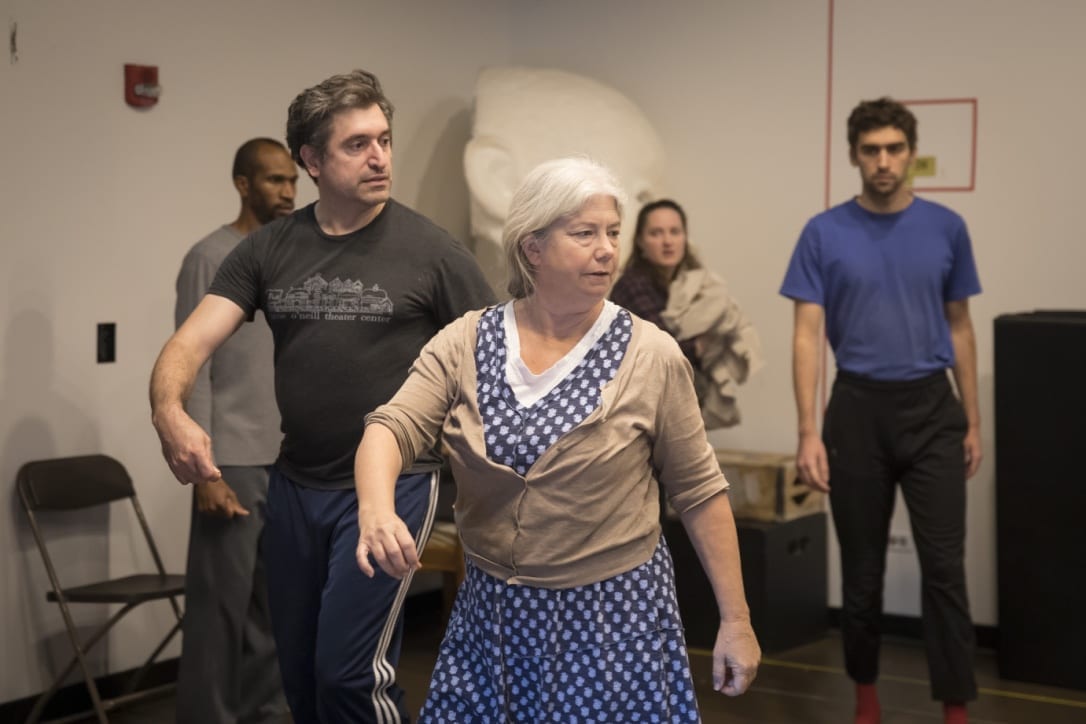By Catie Crandell
Professor Mary Alice Zimmerman, the speaker who delivered this year’s Fagles Lecture for Classics in the Contemporary Arts, is obsessed with the challenge of finding a symbolic language for representing the seemingly unrepresentable. Zimmerman—director, writer, producer and Professor of Performance Studies at Northwestern University— has a long and storied career of transforming non-realist texts such as myths, dreams, and fairytales into spectacles for live audiences. Awarded a Tony in 2002 for her production of the Metamorphoses, Zimmerman used her lecture as a space to discuss the profound challenges and joys of using the theatrical stage to “find a material language to embody something immaterial.”
As she explained in her lecture, this passion was ignited for her as a child reading an illustrated collection of classical myths. One particular image captured her imagination: Psyche surreptitiously peering at her sleeping husband, Cupid, with candle in hand. This image, which captures the climax of the myth in which Psyche is forbidden from knowing the identity of her husband, and is tempted by her sisters into breaking that promise, conjures a series of compelling and challenging questions for Zimmerman, most profoundly: Why should the soul not look directly at love? “I don’t know the answer,” Zimmerman states, “but it compels me.”
As the Fagles lecture amply demonstrated, Zimmerman’s fantastical stagings are often inspired by a striking image that requires creativity to translated to the theater. For instance, Zimmerman describes the sleight of hand necessary for portraying scenes in her adaptation of The Odyssey, staged in 2017 at the Oregon Shakespeare Festival. Showing a series of images from that production, Zimmerman explained how she used a variety of tricks for actors to portray the scenes in the cave of the Cyclops. Using a shadow screen to amplify the silhouette of Polyphemus, the life-sized actors in front of the screen are dwarfed, and then are replaced by doll-sized props behind that screen which can then be dramatically dismembered and consumed. “This scene is always a big hit and it has a comic edge because people delight in the illusion,” Zimmerman explains. This kind of imaginative cooperation between those on stage and those in the audience is particularly central to all of Zimmerman’s productions.
Zimmerman’s favorite compliment came from a child who saw The White Snake, her adaptation of an ancient Chinese legend. The protagonist, a snake spirit, transforms into a beautiful woman in order to experience the human world. This idea was the focal point for Zimmerman, who delighted in the challenge of representing such a protean character on stage. In some scenes the character is presented as a snake puppet, in others by an actor’s serpentine movements, and in others still, as an undulating line of rotating parasols. “When I realized the parasols were also the snake, it was like opening a present,” this young audience member declared. For Zimmerman, this moment of recognition is key: “He saw something and then saw through it. It opened up and multiplied for him.”
In speaking with students of the Humanities Sequence the following day, Zimmerman described other visual “tricks for doing the fantastical.” For instance, the central feature of Zimmerman’s set design for the Metamorphoses was a shallow pool of water that actors enter and interact with. “I knew it was right for the mythic,” she explained, describing how water is a perfect fit because it is used to mark transitions in life such as in baptism, is used colloquially to explain momentous change (such as crossing the Rubicon, the Styx, or the River Jordan). Water itself is changeable as it freezes or evaporates. On the stage it “amplifies motion and emotion” and can transform into a sea, a mire of grief, a backyard pool. In other productions, Zimmerman has created rain with a series of descending silk ribbons, or the ocean with undulating cloths.
In essence, Zimmerman sees herself as taking narratives that could easily be portrayed with the digital effects of film, but instead creating them symbolically on the stage “within the laws of physics.” As she puts it, “That’s the joy: how am I going to manifest this impossible thing?”
The Fagles Lecture was supported by the Departments of Classics and Comparative Literature, the Humanities Council, the Lewis Center for the Arts, the Public Lectures Committee, Seeger Center for Hellenic Studies, and the Program in Humanistic Studies.
















